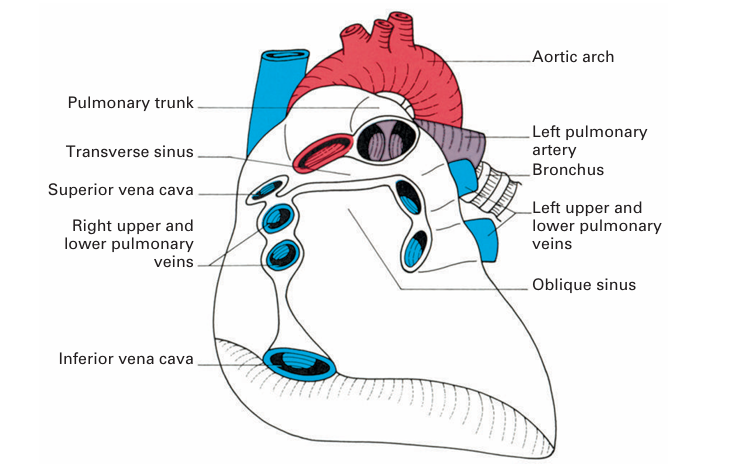
The pericardium
 المؤلف:
Harold Ellis,Vishy Mahadevan
المؤلف:
Harold Ellis,Vishy Mahadevan
 المصدر:
Clinical Anatomy Applied Anatomy for Students and Junior Doctors
المصدر:
Clinical Anatomy Applied Anatomy for Students and Junior Doctors
 الجزء والصفحة:
13th Edition , p30-32
الجزء والصفحة:
13th Edition , p30-32
 2025-02-25
2025-02-25
 785
785
The heart and the roots of the great vessels are contained within the conical fibrous pericardium, the apex of which is fused with the adventitia of the great vessels and the base with the central tendon of the diaphragm. Anteriorly it is related to the body of the sternum, to which it is attached by the sternopericardial ligaments, the 3rd–6th costal cartilages and the anterior borders of the lungs. Posteriorly, it is related to the oesophagus, descending aorta and vertebra T5–T8, and on either side to the roots of the lungs, the mediastinal pleura and the phrenic nerves.
The pericardial cavity is the potential space between the visceral and parietal layers of the pericardium. Just like the pleural and peritoneal cavities, it is lubricated by a film of serous fluid. Following trauma it may fill with blood (haemopericardium).
The inner aspect of the fibrous pericardium is lined by the parietal layer of serous pericardium. This, in turn, is reflected around the roots of the great vessels to become continuous with the visceral layer or epicardium. The lines of pericardial reflexion are marked on the posterior surface of the heart (Fig. 1) by the oblique sinus, bounded by the inferior vena cava and the four pulmonary veins, which form a recess between the left atrium and the pericardium, and the transverse sinus between the superior vena cava and left atrium behind and the pulmonary trunk and aorta in front.

Fig1. The transverse and oblique sinuses of the pericardium. The heart has been removed from the pericardial sac, which is seen in anterior view.
 الاكثر قراءة في علم التشريح
الاكثر قراءة في علم التشريح
 اخر الاخبار
اخر الاخبار
اخبار العتبة العباسية المقدسة


